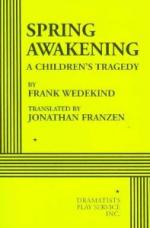
|
| Name: _________________________ | Period: ___________________ |
This test consists of 15 multiple choice questions and 5 short answer questions.
Multiple Choice Questions
1. How must Martha always wear her hair?
(a) In a bun.
(b) Short.
(c) Loose.
(d) Braids.
2. In the most sexual scene of the play, what is alluded to heavily?
(a) Brecht.
(b) The Bible.
(c) Faust.
(d) Goethe.
3. What favor does Moritz ask of Melchior in Act 1, Scene 2?
(a) He asks him to write about sex so he may read it later.
(b) He asks Melchior to help him study.
(c) He asks Melchior to visit him later that night.
(d) He asks him not to tell anyone about his ignorance.
4. What does Wendla claim about the thoughts her mother finds offensive in the first scene?
(a) She says she hears the girls at school expressing similar thoughts.
(b) She says that she overhears her mother expressing these thoughts.
(c) She says they come to her at night.
(d) She says her sister tells her these thoughts.
5. How does Bentley describe Moritz and Melchior in relationship to each other?
(a) A surrogate fatherly relationship.
(b) The result of one person's love not being reciprocated.
(c) Complete opposites.
(d) Extremely alike.
6. How does Moritz feel about his dreams?
(a) He does not understand them.
(b) He believes they are messages from God.
(c) He looks forward to them.
(d) He fears they are evil dreams.
7. In the first scene, what does Wendla wonder about her future?
(a) She wonders what she will look like in a few years.
(b) She wonders what sort of husband she will have.
(c) She wonders if she will make it to adulthood.
(d) She wonders what sort of mother she will make.
8. What is Eros according to Bentley?
(a) Sexual love.
(b) An instinct for life.
(c) Romantic love.
(d) An instinct for death.
9. What do the girls in Act 1, Scene 3 decide they all want one day?
(a) Sons.
(b) Husbands.
(c) Lovers.
(d) Daughters.
10. What is Thanatos according to Bentley?
(a) Sexual love.
(b) Romantic love.
(c) Driving towards death.
(d) A drive towards life.
11. For how long may Wendla wear her old dress?
(a) One more summer.
(b) One more week.
(c) One more year.
(d) One more month.
12. What does Moritz admit to considering if he flunks?
(a) Entering the church.
(b) Suicide.
(c) Running away.
(d) Becoming a criminal.
13. What is the most important relationship depicted in A Children's Tragedy?
(a) Ilsa and Moritz's near romance.
(b) The bond between Moritz and his father.
(c) Melchior and Wendla's relationship.
(d) The friendship between Moritz and Melchior.
14. Who does Bentley believe is the inspiration for the characters of Mr. and Mrs. Gabor?
(a) Wedekind's siblings.
(b) The parents of Wedekind's girlfriend.
(c) Wedekind's parents.
(d) The prime minister and his wife.
15. In the brief summary given in the introduction, what concept is Melchior struggling with?
(a) Nationality.
(b) Political unrest.
(c) Morality.
(d) Sexual preference.
Short Answer Questions
1. What did people find so offensive about A Children's Tragedy when it was first written?
2. Because of the objectionable content of the play, what did Wedekind have to do for the play to be printed?
3. What sort of story is A Children's Tragedy?
4. What does Mrs. Bergmann wonder about Wendla in the first scene?
5. How was the rape scene censored in reissues of A Children's Tragedy?
|
This section contains 607 words (approx. 3 pages at 300 words per page) |

|




